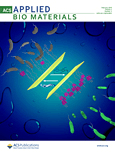
Advanced NanoBiomed Research
Scope & Guideline
Catalyzing Discoveries in Nanobiotechnology
Introduction
Aims and Scopes
- Nanomaterials for Drug Delivery:
Research related to the design and application of nanomaterials as drug delivery systems, enhancing the efficacy and targeting of therapeutic agents. - Tissue Engineering and Regenerative Medicine:
Studies aimed at developing scaffolds and biomaterials for tissue regeneration, focusing on the interaction between cells and engineered materials. - Biosensing and Diagnostics:
Innovations in biosensing technologies utilizing nanomaterials for the detection of biomarkers, pathogens, and diseases. - Cancer Therapy and Immunotherapy:
Research on nanotechnology applications in cancer treatment, including targeted therapy, immunotherapy, and theranostics. - Biocompatible Materials:
Development of biocompatible materials that can interact safely with biological systems for various therapeutic applications. - Microfluidics and Organ-on-a-Chip Technologies:
Application of microfluidic systems for biological assays, drug testing, and modeling of human organs for biomedical research.
Trending and Emerging
- Smart and Responsive Nanocarriers:
Increased research on stimuli-responsive nanocarriers for targeted and controlled drug delivery, which allows for enhanced therapeutic effects and reduced side effects. - Biomimetic Materials:
A growing focus on materials that mimic biological systems, enhancing compatibility and functionality in biomedical applications. - Nanotechnology in Regenerative Medicine:
Emerging studies on the application of nanotechnology for regenerative medicine, including stem cell therapy and tissue repair mechanisms. - Machine Learning and AI in Nanomedicine:
The integration of machine learning and artificial intelligence to predict the behavior of nanomaterials and improve drug design processes is gaining traction. - Multi-Modal Therapeutic Approaches:
Research is increasingly focusing on combination therapies that integrate multiple modalities, including photothermal, photodynamic, and immunotherapy, to enhance cancer treatment outcomes.
Declining or Waning
- Traditional Drug Formulations:
Research focusing on conventional drug formulations and delivery methods seems to be less prevalent, with a shift towards more innovative nanotechnology-based approaches. - Basic Nanomaterial Properties:
Studies that primarily investigate the fundamental properties of nanomaterials without clear biomedical applications are becoming less common. - In Vivo Animal Studies:
There is a noticeable decrease in the number of publications emphasizing in vivo animal studies, as the focus shifts towards more advanced in vitro models and organ-on-a-chip technologies.
Similar Journals

Materials Science & Engineering C-Materials for Biological Applications
Advancing biomaterials for a healthier future.Materials Science & Engineering C-Materials for Biological Applications is a premier journal published by ELSEVIER, dedicated to advancing the field of biomaterials through interdisciplinary research. With a robust ISSN of 0928-4931, this journal has made its mark in the realms of Chemical Engineering and Materials Science, achieving impressive Scopus rankings within its categories, namely Rank #16/151 in Bioengineering (89th percentile) and Rank #13/112 in Biomaterials (88th percentile). Although the journal's coverage in Scopus has been discontinued since 2021, it remains a critical resource for researchers, professionals, and students eager to explore innovative materials and their applications in biological contexts. The journal’s open access policy enhances its accessibility, fostering a global exchange of knowledge and inspiring future advancements in the field of materials science.

ACS Applied Bio Materials
Pioneering Research in Biomaterials for a Healthier TomorrowACS Applied Bio Materials is a leading academic journal published by the American Chemical Society, focusing on the innovative intersection of bioengineering and materials science. Since its inception in 2018, the journal has established itself as a pivotal platform for disseminating impactful research within the fields of Biochemistry, Biomaterials, Biomedical Engineering, and Chemistry, often ranked in the top tiers of these categories. With an impressive impact factor, it holds a Q2 ranking in both Biochemistry and Biomaterials, and a prestigious Q1 ranking in Biomedical Engineering and miscellaneous Chemistry, underscoring its significance in advancing knowledge and practices across these disciplines. The journal’s editorial commitment to high-quality, peer-reviewed research ensures relevance and rigor, appealing to a diverse audience of researchers, professionals, and students keen to explore breakthroughs in bio-related materials technology. The access options enhance its visibility and reach, allowing for a broader dissemination of studies that drive innovation and collaboration in biotechnology and material sciences. Located in the heart of Washington, DC, ACS Applied Bio Materials serves as a crucial resource for advancing the future of healthcare, engineering, and materials research.

Progress in Biomedical Engineering
Empowering research that shapes the future of healthcare.Progress in Biomedical Engineering, published by IOP Publishing Ltd, is a premier open-access journal that serves as a vital platform for the dissemination of innovative research in the field of biomedical engineering. With an impressive Q1 classification in the Biomedical Engineering category for 2023, this journal has established itself as a significant contributor to the advancement of engineering solutions that improve healthcare outcomes. Recognized for its high-quality and impactful publications, it ranks 51st out of 303 in its field on Scopus, placing it in the 83rd percentile. The journal aims to foster interdisciplinary collaboration and introduce pioneering methodologies and technologies that bridge the gap between engineering and medicine. By providing a pathway for rapid communication of fundamental and applied research, Progress in Biomedical Engineering is dedicated to shaping the future of healthcare technology. Access to its content ensures that researchers, professionals, and students remain at the forefront of biomedical innovation.

Regenerative Biomaterials
Elevating Standards in Regenerative BiomaterialsRegenerative Biomaterials, published by Oxford University Press, serves as a premier platform for the dissemination of innovative research in the rapidly evolving field of biomaterials. Since its inception in 2014, this esteemed open-access journal has fostered a collaborative and diverse scientific community, providing free access to impactful articles that enhance our understanding of regenerative medicine and tissue engineering. With a commendable impact factor and ranking within the top quartiles of both Biomedical Engineering and Materials Science, it is recognized for its rigorous peer-review process and high-quality publications. The journal aims to bridge the gap between fundamental research and applied sciences, promoting advanced studies that contribute to clinical applications and regeneration strategies. Researchers, practitioners, and students alike are encouraged to engage with the journal’s content to foster interdisciplinary collaboration and drive future innovations in the biomaterials domain.

Biofabrication
Innovating Solutions at the Intersection of Biology and Technology.Biofabrication, published by IOP Publishing Ltd, stands at the forefront of the interdisciplinary fields of biochemistry, bioengineering, biomaterials, biomedical engineering, biotechnology, and miscellaneous medicine. Since its inception in 2009, this prestigious journal has secured its position within the Q1 category across multiple disciplines as of 2023, reflecting its high impact and significant contribution to advancing research in these domains. With ranks such as #19 in biochemistry and #10 in biomaterials according to Scopus, it showcases groundbreaking studies and innovative methodologies that are crucial for the evolution of biofabrication technologies. Authored by leading researchers and professionals, the journal publishes articles that explore the synthesis, characterization, and application of biomaterials, providing valuable insights for both academic researchers and industry practitioners. The impact factor of the journal, combined with its rigorous peer-review process, guarantees high-quality content that pushes the boundaries of knowledge and technology. Researchers and students engaged in these dynamic fields will find Biofabrication an indispensable resource for staying abreast of critical developments and emerging trends.

BIOMEDICAL MICRODEVICES
Pioneering the Future of Biomedical EngineeringBIOMEDICAL MICRODEVICES is a leading journal published by Springer that focuses on the innovative field of microdevices within biomedical engineering. With an ISSN of 1387-2176 and an E-ISSN of 1572-8781, BIOMEDICAL MICRODEVICES offers a prestigious platform for researchers to disseminate their findings from 1998 to 2024, demonstrating a long-standing commitment to advancing knowledge in this critical area. The journal is recognized for its significant contributions, boasting a Q2 ranking in Biomedical Engineering and Nanoscience and Nanotechnology, and a Q3 rank in Molecular Biology. Renowned for its rigorous peer-review process, it is positioned within the top 30% of its field according to Scopus rankings, making it a valuable resource for researchers and practitioners alike. Though it operates under a subscription model, the emphasis on quality and relevance within its scope ensures that BIOMEDICAL MICRODEVICES remains a vital source of cutting-edge research that bridges engineering and biological systems, fostering innovation and collaboration in the pursuit of novel health solutions.

JOURNAL OF MATERIALS SCIENCE-MATERIALS IN MEDICINE
Transforming Healthcare with Cutting-edge Materials ResearchJOURNAL OF MATERIALS SCIENCE-MATERIALS IN MEDICINE is a leading peer-reviewed journal published by Springer, dedicated to advancing the field of biomedical materials science. With an ISSN of 0957-4530 and E-ISSN 1573-4838, this Open Access journal has been committed to providing researchers and professionals with freely accessible, high-quality research since 2021. It features an extensive scope spanning bioengineering, biomaterials, biomedical engineering, and biophysics, reflecting its significant impact within these interdisciplinary domains. Recognized within the Q2 category of the 2023 rankings in multiple fields, the journal proudly positions itself as a crucial resource for innovative materials that contribute to advancements in medical applications. With impressive Scopus rankings, including 26th in Biophysics and 40th in Materials Science for Biomaterials, researchers, students, and industry professionals alike can rely on this publication for cutting-edge insights that drive the future of medical materials and technologies. Based in Dordrecht, Netherlands, the journal provides a vibrant platform for sharing groundbreaking discoveries and fostering collaborative research among a global audience.

COLLOIDS AND SURFACES B-BIOINTERFACES
Innovating Interactions for Tomorrow's BiotechnologyCOLLOIDS AND SURFACES B-BIOINTERFACES is a premier interdisciplinary journal published by Elsevier, dedicated to advancing the knowledge of interfaces and interactions in biological systems and their applications in biotechnology. With an impressive impact factor that underscores its significance in the field, the journal ranks in the Q1 category for Biotechnology, Medicine, and Physical and Theoretical Chemistry in the 2023 classifications. It has achieved notable positions in Scopus rankings, highlighted by a top-tier rank in Colloid and Surface Chemistry, demonstrating its influence on ongoing research. Spanning from 1993 to 2025, C&B B-BIOINTERFACES serves as a vital platform for innovative research contributions, fostering knowledge exchange among researchers, professionals, and students. The journal focuses on the intricate relationships between colloids, surfaces, and biological materials, paving the way for groundbreaking developments in drug delivery, biomaterials, and nanotechnology. While not an open-access publication, readers can anticipate insightful, high-quality articles that significantly impact the scientific community.

Annual Review of Biomedical Engineering
Bridging Engineering Excellence and Medical AdvancementsAnnual Review of Biomedical Engineering, published by Annual Reviews, stands as a leading academic journal dedicated to the rapidly evolving field of biomedical engineering. With an impressive impact factor that reflects its high citation rates and rigorous peer-review process, this journal offers critical insights by synthesizing cutting-edge advancements and applications in both biomedical engineering and miscellaneous medicine. The journal, which is available in both print (ISSN: 1523-9829) and electronic formats (E-ISSN: 1545-4274), serves as an essential resource for researchers, professionals, and students aiming to stay abreast of significant developments and emerging trends. As of 2023, it is recognized in the top tier (Q1) for both Biomedical Engineering and Medicine, showcasing its esteemed position within the academic community, reflected in its high Scopus rankings. Spanning from 1999 to 2024, the Annual Review of Biomedical Engineering continues to catalyze interdisciplinary collaboration and innovation at the intersection of engineering and healthcare.

Biomaterials Research
Unveiling the potential of biomaterials for healthcare.Biomaterials Research, published by the American Association for the Advancement of Science, is a prominent open access journal established in 2014, dedicated to advancing the field of biomaterials. Based in the United Kingdom, this journal has swiftly become an essential platform for researchers and practitioners, offering groundbreaking insights in biomaterials, biomedical engineering, ceramics and composites, and miscellaneous medical fields. With its impressive Q1 ranking across multiple relevant categories in 2023 and its strong Scopus rankings, including a remarkable 90th percentile in the medicine category, Biomaterials Research showcases high-quality, peer-reviewed research designed to address both practical and theoretical challenges in biomaterials science. As an open access journal, it promotes wider dissemination and accessibility of research findings, crucial for fostering innovation and collaboration within the scientific community. Researchers, professionals, and students alike are encouraged to contribute, read, and engage with the latest developments in this dynamic field.